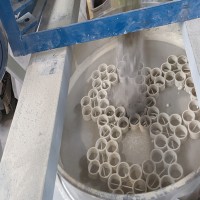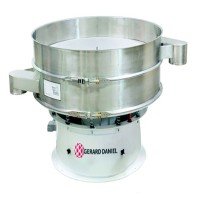Case Study: U.S. Heritage Group
Preserving history with a Gerard Daniel Separator Machine
The US Heritage Group is a Chicago-based company specializing in masonry restoration products. They produce historically accurate mortars and coatings, consultation, and training. They even do chemical analysis of material samples to ensure they perfectly match the original. They have supplied materials and guidance for building restorations from The Alamo to the Yerkes Observatory.
Why go to all the Trouble?
Why go to all that trouble when the local hardware store has bags of mortar and gallons of paint ready to go? Won’t they do a better job than that old stuff anyway? The reason for using historically accurate mortars and coatings on old buildings is not because of some esoteric historian reasoning or a Luddite aversion to hardware stores. Tai Olson, US Heritage’s Director of Operations, explained that older construction materials and practices resulted in buildings that were slightly permeable and flexible, whereas modern construction aims for airtight and impermeable. The old-fashion masonry could breathe, absorbing or exhausting moisture from the air.

The Problem
An even, consistent, homogenous blend of all the powder ingredients is essential to their product performance. A powder component in one of their mortar mixes has a bad habit of clumping together on humid days, compromising the homogeneity of the finished product. Tai found Gerard Daniel while looking for Sand Screeners for a different part of their operation and recognized that a separator machine could provide a tremendous labor saving over manually trying to get the hydrophilic lumps to incorporate into the blend.
Sealing off that air and moisture exchange with an impenetrable layer of modern paint or mortar will either dehydrate or drown the historic materials, accelerating the building’s decay like a sandcastle that has gotten too dry or too wet.
| “There was distinct shift in the way buildings were constructed between maybe the 1940s and 50s, that if you take an older building, like a 1930s or earlier building, and you put a bag of ready-mix on it, you put a gallon of latex paint on it, you’re actually going to cause more harm than the restoration [is remedying].” – Tai Olsen |
Configuration & Solution
The challenge with US Heritage Group’s product is that the clumping material could not simply be separated and cast aside like with most separator applications. They were not lumps of homogenous product, but rather, lumps of just one component, so discarding the lumps would change the ratio in the blend.
Tai sent a product sample to Gerard Daniel. It posed a unique problem not addressed by any routine separator configuration. Gerard Daniel came up with an equally unique solution to the problem:
- Set the counterweight lead-angle to keep material evenly distributed on the screen instead of migrating outward.
- Install the screen upside down so the materials must remain on the screen until the lumps are broken down.
- Put a cluster wheel on the screen to break up the lumps into a fine powder.

Once Tai saw that the separator was fully processing the product, it was time to integrate the machine into their process line. The machine fit nicely on a metal frame they already had. The frame raises the discharge chute to chest height for convenient benchtop pail filling. The frame also supports the feet of a cone bottom hopper, positioning the hopper’s slide gate conveniently above the screen frame. They equipped it with an extra-long power cord so it could be put to use anywhere around the factory, and fork pockets in the frame allow for convenient forklift mobility when it is time to move it around the factory or into storage when not in use.
Vibratory Separator Machine Specs:
- Performa™ 30 model
- 30-inch diameter, 700 square inch screen
- 2/3 horsepower motor
- 230-volt 3-phase power connection
- 450 lbs. overall weight
- 1 screen deck
- 1 #16M x 0.018” market-grade screen (upside down)
- 1 cluster wheel to deblind the screen

Gerard Daniel Expertise
With over 70 years of experience in wire mesh solutions, our applications engineers collaborate with our customers to improve performance and reduce cost in a wide range of separation applications in food and beverage, agricultural, and industrial processing. With multiple operations in the US as well as Canada and Ireland, Gerard Daniel Worldwide is a leading provider of mesh, filtration and separation solutions used in a broad array of critical OEM and MRO applications. Increase your productivity and lower your production costs by consulting with the screening experts at Gerard Daniel Worldwide.